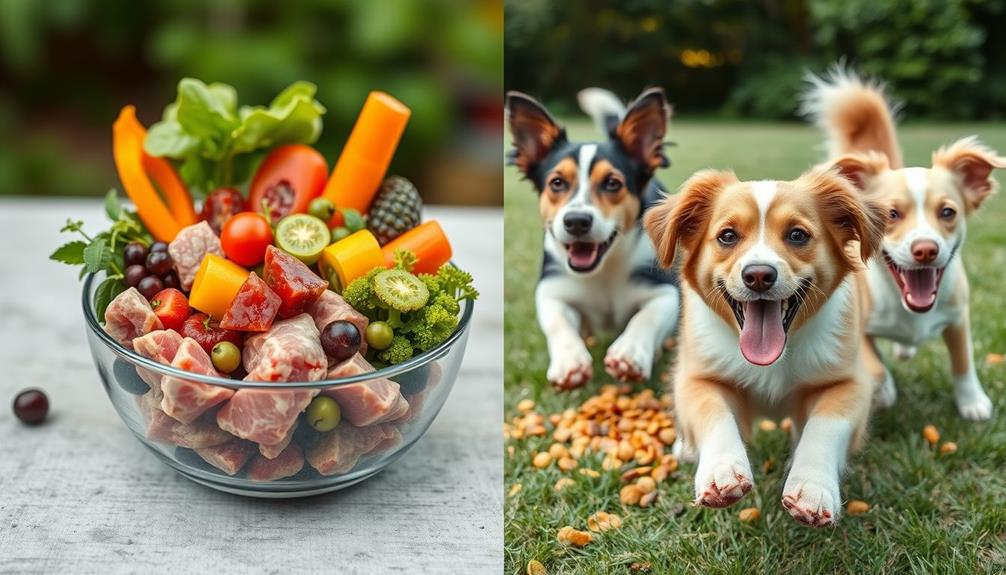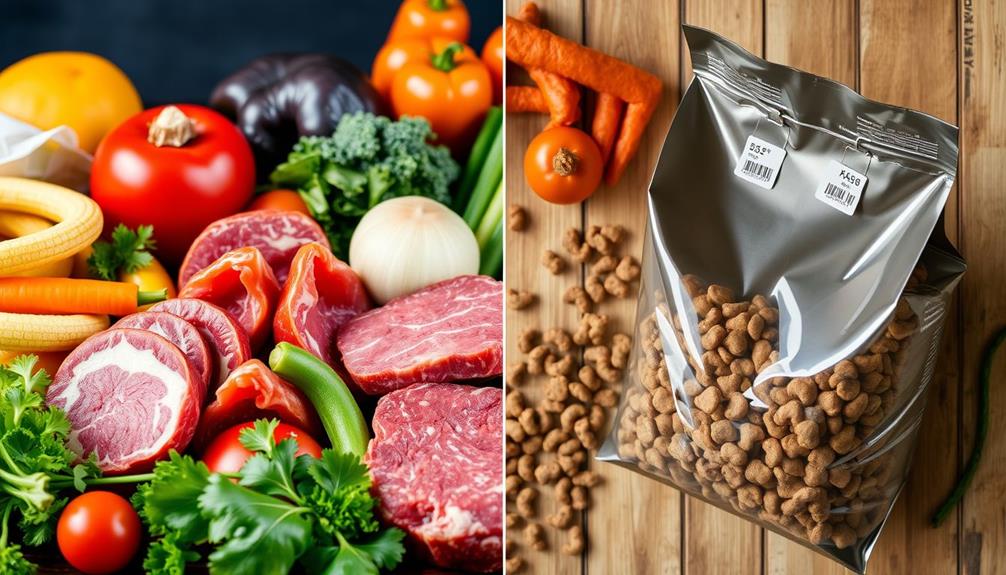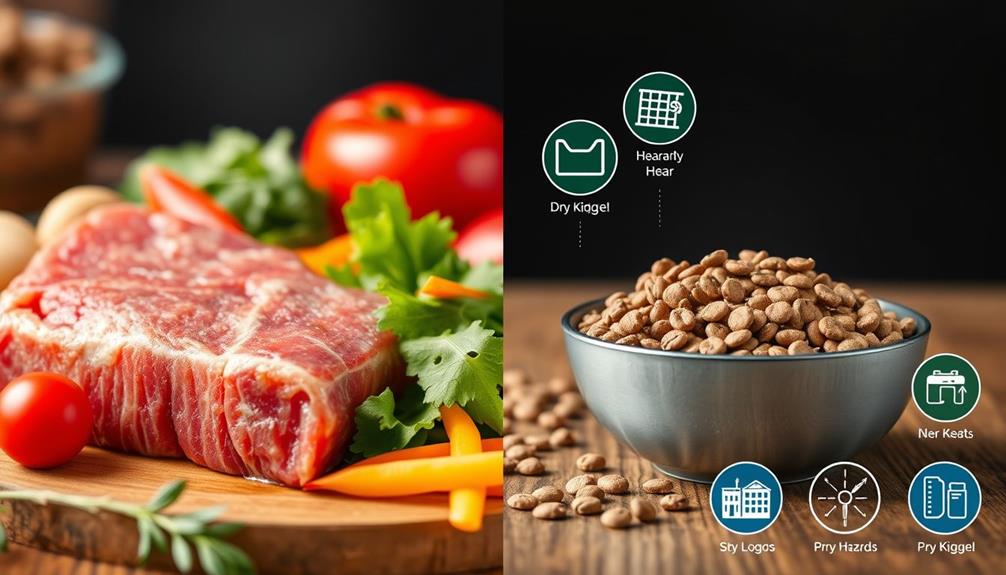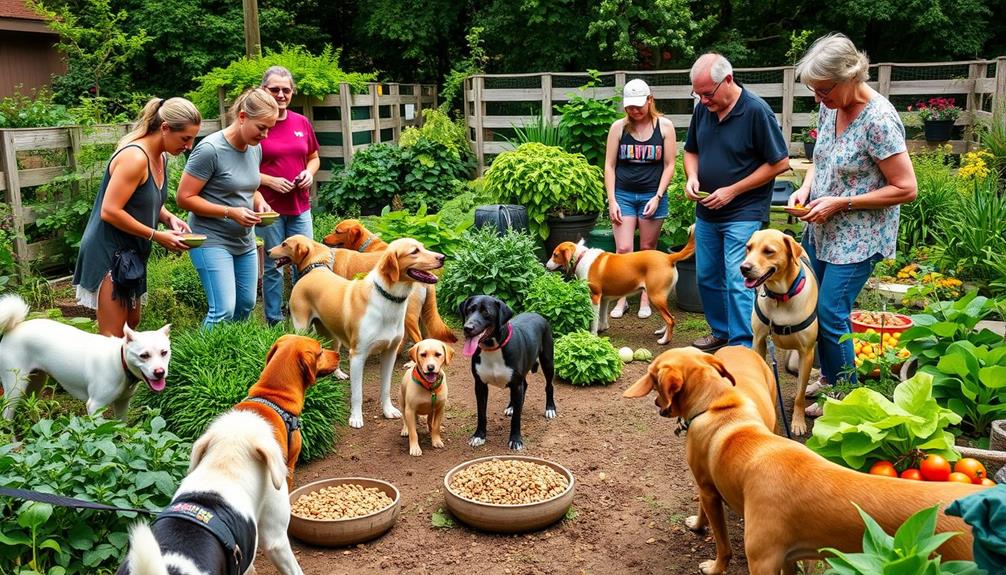When choosing between raw food and kibble for your dog, it's important to know that raw meat-based diets generally offer better nutrition. They have lower carbohydrates, which can enhance digestion and reduce the risk of obesity. Kibble, while convenient, often contains fillers that may not be suitable for all dogs. However, raw diets require careful handling to avoid health risks. If you opt for raw, a gradual shift to prevent digestive upset is key. Understanding the pros and cons of both options will help you make an informed choice for your furry friend. More insights await you on this topic!
Key Takeaways
- Raw meat-based diets (RMBD) contain under 10% carbohydrates, promoting better digestion and lower obesity risk compared to kibble's 30%-40% carbohydrates.
- RMBDs maintain natural enzymes and nutrients, while kibble often requires synthetic supplements due to nutrient loss during processing.
- Dogs on RMBDs show improved health markers and lower inflammatory responses compared to those fed kibble.
- Transitioning to raw requires careful monitoring to prevent digestive upset and ensure balanced nutrition, often needing veterinary guidance.
- Kibble is convenient, shelf-stable, and may be suitable for dogs with specific health needs, offering a balanced mix of nutrients.
Nutritional Comparison
When comparing the nutritional profiles of raw meat-based diets (RMBD) and kibble for dogs, several key differences stand out. Raw diets typically contain under 10% carbohydrates, while kibble can feature 30%-40%. This lower carbohydrate level in raw diets may lead to better digestion and a decreased risk of obesity in your dog.
Additionally, kibble processing often involves extreme heat that destroys essential nutrients, requiring synthetic supplements to replace them. In contrast, raw diets preserve natural enzymes that aid in digestion and enhance nutrient absorption.
Furthermore, the significance of selecting the right cold medication for pets can also play a role in their overall health.
When it comes to moisture content, raw diets boast a remarkable 70-75% moisture, promoting better hydration in your dog. Kibble, on the other hand, only offers 5-10% moisture, which can increase the risk of dehydration.
You might also notice that nutritional supplementation is more common among RMBD dogs, with 85% receiving supplements compared to only 24% of kibble-fed dogs. This highlights not only the differences in dietary composition but also in owner management practices, which can greatly impact your dog's overall health and well-being.
Carbohydrate Content

The carbohydrate content in your dog's diet plays a significant role in their overall health. Kibble diets typically contain 30%-40% carbohydrates, while raw meat-based diets (RMBD) have less than 10%. This stark difference aligns RMBDs more closely with your dog's natural dietary needs.
High carbohydrate levels in kibble can lead to obesity, pancreatitis, and diabetes, as dogs don't have a biological need for these carbs. Understanding common financial terms can also help you budget for your dog's dietary needs effectively.
When you feed your dog kibble, the excessive carbohydrate content may cause digestive issues and alter their gut microbiota, negatively impacting their well-being. In contrast, raw diets eliminate fillers, gluten, and grains, which promotes better digestion and reduces the risk of health complications associated with high carbohydrate intake.
Moreover, research shows that RMBDs provide better nutrient bioavailability, ensuring your dog absorbs essential nutrients more effectively.
Lower inflammatory markers in raw diets further highlight the potential benefits over high-carbohydrate kibble diets. By considering the carbohydrate content in your dog's food, you can make a more informed choice to support their health and happiness.
Health Implications

Health implications of your dog's diet play an important role in their overall well-being. Raw meat-based diets (RMBD) have been associated with lower serum alkaline phosphatase levels and higher lymphocyte counts, indicating potential health benefits compared to kibble diets.
Dogs on RMBD often show improvements in clinical condition scores and firmer fecal consistency, suggesting better overall health and digestion. Additionally, RMBD can provide a rich source of antioxidants and vitamins, which may support your dog's immune system and overall wellness, similar to the benefits seen in Cranberry Juice Consumption.
In contrast, kibble diets may pose health issues due to advanced glycation end products (AGEs) generated during processing, which can contribute to inflammation and chronic health problems. The high carbohydrate content in kibble can lead to obesity, pancreatitis, and diabetes, while RMBD eliminates these non-beneficial carbohydrates, promoting a healthier weight and improved energy levels.
However, it's essential to remember that over 90% of dogs on raw meat diets may experience nutritional imbalances. This underscores the significance of balanced diet formulation to guarantee your dog's nutritional needs are met.
Ultimately, weighing the health implications of each diet can help you make an informed decision that supports your dog's health and longevity.
Transitioning to Raw

How can you make the shift to a raw food diet for your dog smooth and successful? Start by gradually shifting from a kibble diet to raw food. This method helps prevent digestive upset, allowing your dog to adjust better. A structured switching guide can be invaluable during this process, outlining the steps to take for a successful shift.
Incorporating fresh fruits and vegetables, similar to what's recommended for small pets like hamsters, can provide additional nutrients during this shift proper diet recommendations. Consider mixing warmed bone broth with the raw food to enhance its palatability and support gut adjustment. This addition not only makes the food more appealing but also aids in digestion.
Remember, even a small amount of raw food can greatly boost your dog's nutrition, so don't hesitate to introduce it alongside kibble if necessary.
Patience is key during this adjustment period. Some dogs may take longer to adapt to their new raw food diets, so stay attentive to their needs and reactions. Monitor your dog's response, and if they experience any digestive upset, slow down the process.
With time and careful attention, you'll help your dog embrace a healthier, more nutritious diet that can enhance their overall well-being.
Veterinary Opinions

When choosing between raw food and kibble for your dog, it's essential to contemplate veterinary opinions on both diets.
Some veterinarians emphasize the importance of ensuring balanced nutrition, similar to how mammography aims to detect breast cancer early for better treatment outcomes, mammography guidelines.
While some vets highlight the nutritional benefits of kibble, others caution about the safety risks associated with raw diets.
Understanding these perspectives can help you make an informed decision for your pet's health.
Vet Perspectives on Diets
While opinions among veterinarians about raw food diets for dogs vary considerably, many share concerns about the potential health risks associated with pathogens in raw food.
Vet perspectives on raw meat-based diets (RMBD) highlight both potential health advantages and significant risks. For example, research indicates that dogs on RMBD often show lower serum alkaline phosphatase levels and higher lymphocyte counts, suggesting some health benefits over kibble.
Additionally, understanding the financial considerations for elderly care can help pet owners make informed choices regarding their dogs' diets and overall health management.
However, veterinarians caution that a lack of standardized guidelines for raw diets can lead to nutritional imbalances, as noted in over 90% of dogs on these diets.
Moreover, studies reveal that 85% of RMBD dogs receive dietary supplements, compared to only 24% of kibble-fed dogs, indicating different management practices that could affect health outcomes.
Proper handling and preparation of raw food are vital to mitigate health risks not only for dogs but also for humans.
Given these factors, it's important to weigh the pros and cons of RMBD carefully. Consulting with your vet can provide valuable insights into canine nutrition, ensuring that you choose a diet that supports your dog's health and well-being.
Safety Considerations for Raw
Veterinary opinions on the safety of raw diets highlight the critical need for proper handling and sanitation to reduce the risk of bacterial contamination. Raw diets can pose serious health risks not only to your dog but also to your family. Many vets emphasize that without strict adherence to safety measures, you could encounter problems such as gastrointestinal diseases.
| Safety Concerns | Recommended Actions |
|---|---|
| Bacterial Contamination | Practice proper handling techniques |
| Nutritional Imbalances | Consult veterinary advice regularly |
| Pathogen Risks | guarantee safe sourcing and storage |
| Gastrointestinal Issues | Monitor your dog's health closely |
Research reveals that over 90% of dogs on raw meat diets experience nutritional imbalances, which can lead to further health complications. To prevent these risks, veterinarians strongly advise seeking professional guidance when considering raw feeding. Emphasizing balanced nutrition and proper preparation techniques is essential for keeping your furry friend healthy and safe. By implementing these safety measures, you can enjoy the benefits of a raw diet while minimizing potential dangers.
Nutritional Benefits of Kibble
Many pet owners seek alternatives to raw diets, and high-quality kibble often emerges as a favored option due to its nutritional benefits. Kibble is designed to meet USDA regulations for safety and nutritional balance, ensuring a consistent food source for your dog. When formulated correctly, it typically contains a balanced mix of protein, carbohydrates, vitamins, and minerals, supporting your dog's overall health.
Additionally, choosing a reputable kibble brand can help protect your dog's health, as avoiding scams in pet nutrition is vital for ensuring quality.
Veterinarians often point out that the processed nature of kibble provides a longer shelf life and convenience for pet owners. This reduces the risk of spoilage, which can be a concern with raw diets.
While some may question the use of preservatives in kibble, they do play a role in ensuring safety and stability, keeping the food fresh for longer periods.
For dogs with specific health issues or dietary sensitivities, high-quality kibble can be a practical choice. It offers a nutritionally appropriate option without the complexities of raw diets.
Cost Analysis

When considering the cost of feeding your dog, it's important to weigh both the daily expenses and the potential long-term savings. A standard kibble diet usually ranges from $1 to $13 daily, while raw food diets can cost between $3 and $10 or more each day.
Initially, raw diets might seem pricier, but they often lead to reduced veterinary visits due to improved health, which can offset those higher costs. Additionally, incorporating healthy dog snacks into your dog's diet can further enhance their well-being and may prevent costly health issues down the line.
Healthy dog snacks can provide essential nutrients and support overall wellness. Kibble-fed dogs are more prone to health issues, potentially increasing long-term veterinary care expenses.
By investing in a balanced raw diet, you could contribute to your dog's longer, healthier life, ultimately lowering overall lifetime expenses related to health problems. If a full raw diet feels too expensive, consider mixing raw toppers with kibble. This approach gives your dog nutritional enhancement while keeping costs lower than committing to a complete raw food diet.
In your cost analysis, think about not just the daily price but also the potential savings from fewer health-related issues down the line. Making an informed choice now can lead to healthier outcomes and reduced expenses in the future.
Safety and Risks

Raw dog food diets often carry significant safety risks that pet owners should be aware of. One major concern is the presence of harmful bacteria like Salmonella and E. coli, which can pose health risks not only to your dog but also to your family, especially if you have vulnerable individuals at home.
Additionally, studies have found antibiotic-resistant bacteria in raw pet food, raising alarms about the potential spread of resistant strains. Individuals with Borderline Personality Disorder (BPD) may also experience heightened emotional responses and impulsivity, sometimes extending to their pet care choices, which can lead to further complications in dietary decisions emotional dysregulation in BPD.
Moreover, over 90% of dogs consuming raw meat diets experience nutritional imbalances, which can lead to various health issues. These imbalances are often due to improper handling and preparation, underscoring the requirement for stringent safety measures.
Raw diets have also been linked to an increased risk of gastrointestinal diseases, further emphasizing the importance of monitoring your dog's health.
Veterinarians strongly recommend seeking veterinary guidance to guarantee that any raw dog food diet meets nutritional adequacy and safety standards. By doing so, you can help mitigate the risks associated with raw feeding and promote a healthier lifestyle for your furry friend.
Always prioritize safety when considering a raw diet for your dog.
Community Resources

When considering your dog's diet, tapping into community resources can be a game changer.
Online support groups connect you with fellow pet owners and expert nutritionists who can guide you through the raw versus kibble debate, offering insights into best ways to earn money online that can help cover your pet's dietary needs.
Plus, local raw food co-ops can help you find quality ingredients while sharing valuable tips on feeding practices.
Online Support Groups
While traversing the world of dog nutrition, you'll find that online support groups can be a treasure trove of information and community. These platforms, like "The Pack," allow pet owners to share experiences about raw food and kibble diets, helping you navigate the complexities of canine nutrition.
You can engage in discussions that highlight the health benefits many have observed after changing their dogs to raw diets. Groups often emphasize the importance of consulting with veterinary nutritionists to guarantee that meals are balanced and tailored to your dog's specific needs. This professional guidance is vital, especially when moving to raw food, where nutritional resources can be scarce.
In these online communities, you'll also discover testimonials and success stories that can inspire you and provide insights into the potential improvements in your dog's health. Additionally, many groups offer expert advice, recipes, and tips for safe handling and preparation of raw food, making it easier for you to make informed decisions about your pet's diet.
Expert Nutrition Guidance
Maneuvering the complex world of dog nutrition can feel overwhelming, but expert guidance is readily available through community resources. Online communities, like "The Pack," provide a platform for discussions on pet well-being, where you can connect with fellow dog owners who are also shifting to raw diets. This shared experience can be invaluable as you navigate feeding raw.
Bella & Duke offers tailored meal plans that comply with AAFCO standards, guaranteeing your pup gets balanced nutrition. They also provide educational resources on the differences between raw, vegan, and commercial dog food. Consulting a veterinarian knowledgeable about raw diets is essential to guarantee safe feeding practices and address your dog's specific health needs.
Regular communication with veterinary nutritionists enhances pet health management, helping you optimize your dog's diet, especially during the shift from kibble to raw.
Community resources often include guidance on food storage, preparation safety, and monitoring for any adverse reactions to new diets. With the right expert nutrition guidance and support, you can confidently make informed choices that benefit your dog's overall health and well-being.
Local Raw Food Co-ops
Expert guidance on dog nutrition can lead you to local raw food co-ops, which are fantastic community resources for pet owners exploring raw diets. These co-ops provide access to fresh, species-appropriate raw diets for dogs, often sourcing high-quality ingredients directly from local farms.
By joining a local co-op, you benefit from cost savings on bulk purchases and shared shipping options, making raw feeding more affordable.
Many co-ops also offer educational resources and workshops to help pet owners understand the benefits of raw diets and learn safe handling practices. This knowledge is invaluable as you shift your dog to a new diet.
Additionally, local co-ops often facilitate community discussions and support groups, allowing you to connect with other pet owners who share your interests and concerns about raw feeding.
Some co-ops even partner with veterinary nutritionists to provide tailored meal plans and nutritional consultations. This personalized guidance guarantees that your dog receives a balanced diet that meets their specific needs.
Engaging with your local raw food co-op can enhance your experience, providing you with the tools and support necessary for successful raw feeding.
Key Takeaways

Choosing between raw food and kibble for your dog can considerably impact their health. Understanding the differences can help you make an informed decision. Here are some key takeaways:
Switching to raw food for dogs can provide higher nutritional value compared to kibble, as it contains natural enzymes and nutrients that can be lost during the cooking process. Additionally, raw food has been linked to improved digestion, healthier skin and coat, and higher energy levels in dogs. However, it’s important to consult with a veterinarian before making the switch to ensure that you are providing a balanced diet for your pet.
| Aspect | Raw Meat-Based Diets (RMBD) | Kibble |
|---|---|---|
| Protein & Fat Levels | Higher | Lower |
| Carbohydrate Content | Minimal | 30%-40% |
| Moisture Content | 70-75% | 5-10% |
RMBDs promote better digestion and nutrient absorption due to natural enzymes, unlike kibble, which often undergoes high-temperature processing. The increased moisture in RMBDs enhances hydration, supporting overall health in dogs. Studies have shown that dogs on RMBDs have lower serum alkaline phosphatase levels, indicating improved health.
However, shifting to a raw diet should be gradual to prevent gastrointestinal upset. Always consult with a veterinarian to guarantee balanced nutrition and address any potential health issues. Ultimately, whether you choose RMBD or kibble, focusing on your dog's nutritional needs is key to raising healthy dogs.
Frequently Asked Questions
Is Raw Food Healthier for Dogs Than Kibble?
You might notice that raw food often provides higher protein and fat levels, potentially leading to better health outcomes. However, consider the risks of bacterial contamination and nutritional imbalances that could affect your dog's well-being.
Should I Feed My Dog Dry or Raw Food?
When considering what to feed your dog, it's essential to investigate both options. You'll find raw diets may provide more natural nutrients, while kibble often contains fillers. Evaluate their health needs and preferences carefully.
What Is the Healthiest Food to Feed Your Dog?
When considering the healthiest food for your dog, focus on high-quality ingredients, balanced nutrition, and appropriate moisture content. Consulting with a vet can help you choose the best diet tailored to your dog's needs.
What Is the Healthiest Food to Feed Your Dog?
Imagine your dog feasting like a prehistoric wolf! To keep them healthy, focus on high-quality, species-appropriate food. It'll boost their energy, coat, and digestion. Trust me, your furry friend will thank you for it!
Conclusion
When it comes to choosing between raw food and kibble for your dog, the decision boils down to what suits your furry friend best. Just remember, "Every dog is unique." Consider their nutritional needs, health implications, and your lifestyle before making a switch. Whether you opt for raw or stick with kibble, always prioritize your pup's well-being. With the right information and resources, you can guarantee your dog thrives on whatever diet you choose.










